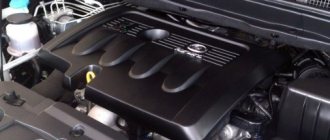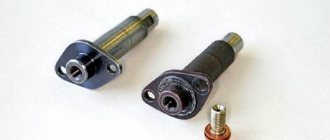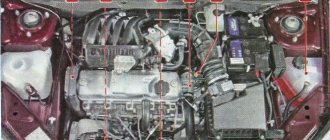16 valve engines
Sixteen valve engines on the Grant were installed under numbers 126 and 127. Initially, the Grants were equipped with a 126 engine, this engine was installed from 2011 to 2015, later replacing the 126, the 127 engine came, which was installed on the Priora 2 and Lada Vesta.
Engine VAZ 21126
This engine was built on the basis of a 124 engine, which is still famous for its reliability. The 126 engine uses automatic tensioning of the timing belt, which avoids the attraction of the belt, which can lead to its breakage. The 16-valve engine uses hydraulic compensators, which allows the engine to adjust the valve clearance under the influence of oil pressure. Also paired with a 16-valve engine in the LUX configuration, an automatic transmission is installed. A significant disadvantage of the 126 engine is the bending of the valves when the timing belt breaks.
Technical characteristics of engine 21126:
| Fuel supply | Injector |
| Number of cylinders | 4 |
| Number of valves | 16 |
| Compression ratio | 11 |
| Power (hp) | 98 |
| Engine capacity (cc. cm) | 1596 |
| Required fuel | Not lower than AI 95 |
| Torque (N*m) | 145 |
Engine VAZ 21127
The VAZ 127 engine is the flagship of the Volzhsky plant. It is this engine that is currently installed on VAZ cars; thanks to the modified DOHC valve timing, it was possible to significantly increase the power of the power unit, which has a very positive effect on the driving characteristics of the car.
Technical characteristics of VAZ 21127:
| Fuel supply | Injector |
| Number of cylinders | 4 |
| Number of valves | 16 |
| Compression ratio | 11 |
| Power (hp) | 106 |
| Engine capacity (cc. cm) | 1596 |
| Required fuel | Not lower than AI 95 |
| Torque (N*m) | 148 |
Review of Lada Granta 219010
The length of the sedan body is 4260 mm, its width is 1700 mm, and its height is 1500 mm. The wheelbase of the car is 2475 mm. The dimensions of the liftback differ from the sedan only in the length of the body, which has decreased slightly and is 4246 mm. The fuel tank volume (50 l) is the same for all modifications. The luggage compartment volume is 480 liters for the sedan, 440 liters for the liftback.
The front brakes are ventilated discs, the rear brakes are drums. The front suspension is independent, McPherson type, the rear suspension is spring semi-independent. Curb weight - 1115 kg, number of passenger seats - 5. For the Grant family, there are three power units with a capacity of 83 to 106 horsepower (hp). Transmission - manual or automatic.
There are a total of 5 possible engine and transmission combinations; which one to choose, everyone decides in accordance with their own requirements. The minimum “standard” configuration is equipped with a 1.6-liter gasoline engine with a capacity of 83 hp. s and a simple five-speed manual transmission. The maximum speed does not exceed 164.5 km/h, acceleration to the first hundred takes 12.5 seconds.
Maximum torque - 132 Nm with a speed of 3500 rpm. The minimum ground clearance is 160 mm. If the car is empty, then the ground clearance reaches 175 mm. Fuel is AI-95 gasoline, consumption is 9.3 liters in the urban cycle and 6.2 liters on the highway. In the combined cycle, consumption is 7.4 liters. The content of harmful substances in the exhaust gases complies with the Euro-4 standard.
The steering wheel can be turned all the way by four turns. The steering mechanism is rack and pinion. The equipment includes daytime running lights, a full-size spare tire, ISOFIX mounts, folding rear seats, a driver airbag, audio preparation, and inertia seat belts. Only 16% of the 20 thousand Lada Granta cars sold corresponded to the “standard” modification. The remaining 84% belong to “norm” or “luxury”.
Regarding the Granta liftback, they plan to equip its “luxury” with a more powerful engine of 106 hp. s., which will be associated only with mechanics. Today, the Granta liftback is the most powerful car of this family. The weakest engine for a liftback is 87 hp. With. Just like the sedan, the five-door Granta will be equipped with both a manual transmission and an automatic transmission.
Along with a slight reduction in body length, the number of cubic meters was also reduced. l luggage compartment, and ground clearance. The liftback trunk volume is 440 liters. But if necessary, its capacity can be easily increased by removing the shelf or folding the back row of seats. The minimum ground clearance is 140 mm for cars with automatic transmission, the ground clearance of Grants liftback with a manual transmission is 160 mm.
8 valve engines
Unlike 16 valves, a single-shaft gas distribution system is used here. There are two valves for each cylinder: intake and exhaust. Such engines are reliable and do not bend valves when the timing belt breaks, but are significantly inferior in the dynamic performance of the vehicle, as well as in the noise level of the internal combustion engine.
Engine VAZ 11183
This engine was installed not only on Grants, but also on the last 2114 years of production. The engine is quite noisy and requires frequent valve adjustment due to the lack of hydraulic compensators. 183 the engine does not bend the valve when the timing belt breaks. This is the only engine installed on the Grant that is not afraid of timing belt breakage.
Technical characteristics of VAZ 11183:
| Fuel supply | Injector |
| Number of cylinders | 4 |
| Number of valves | 8 |
| Compression ratio | 10 |
| Power (hp) | 82 |
| Engine capacity (cc. cm) | 1596 |
| Required fuel | Not lower than AI 95 |
| Torque (N*m) | 120 |
Engine VAZ 11186
This engine is installed in the last years of Granta production. It significantly reduced the noise characteristics and increased the compression ratio, which led to the meeting of the valves with the pistons when the timing belt breaks. Increasing the compression ratio made it possible to achieve more power from the internal combustion engine, which was beneficial for the dynamic characteristics.
Technical characteristics of VAZ 11186:
| Fuel supply | Injector |
| Number of cylinders | 4 |
| Number of valves | 8 |
| Compression ratio | 10,5 |
| Power (hp) | 90 |
| Engine capacity (cc. cm) | 1596 |
| Required fuel | Not lower than AI 95 |
| Torque (N*m) | 143 |
How long does my Lada last without major repairs - an expert opinion
Practice shows that some VAZ engines do not even survive the warranty age and mileage. That is 3 years and 100,000 km. At the same time, there are many Lada owners who talk about mileages exceeding 250,000 km without major repairs. Both are true. Why is there such a big difference?
The service life of most imported motors, when used correctly, varies within +/- 20%. And the owners of modern Ladas, just like thirty years ago, can say about their car that they were lucky (or unlucky) with the engine. In this case, the initial resource of one VAZ engine may differ several times from the resource of another, similar one. But even a successfully assembled engine is not always the key to its long life. The resource can be reduced significantly by using low-quality operating fluids, consumables and spare parts.
The owner can decide to overhaul the engine in two cases:
- Emergency motor failure.
This is when the engine stalls, won't start, and may not turn over. - Engine performance has deteriorated.
The engine starts, but there are: huge oil consumption, smoking, decreased power, poor starting due to spark plugs covered with soot.
Series 21126 and 21127
Often, when buying a luxury Lada Granta, buyers think about which engine is better. In this case, you should also decide what the buyer is willing to sacrifice: power (which he can boost by tuning the Lada Granta engine) or the high cost of engine repairs.
Engine 211126, also installed on the Lada Priora, has a volume of 1.6 liters and a 16-valve cylinder head (cylinder head) system. If the buyer does not want to deal with the problem of bending valves, it is better to choose a different motor. The advantage of this engine is its high power. According to the passport data, it is 98 liters. s., but tests on stands showed higher results.
For fans of engines with absolute pressure sensors instead of a mass air flow sensor, it is better to choose 21127. This engine has 106 horsepower, which is provided by a modified and larger receiver, this power is felt, especially at low speeds. The car is more dynamic when overtaking or making a sharp start.
Transmission
Common problems
All cars are strictly front-wheel drive, and the only thing you need to keep an eye on is the CV joint. Here they are not eternal, but you can count on 150-200 thousand service life with any engine. The main thing is not to turn the “nickels” in reverse and not to pull trailers. Well, constantly check the integrity of the covers - they are weak, the clamps on them often rot within 5 years.
Mechanical boxes
The main types of gearboxes for Grant are 2110, the old gearbox with rod drive, and the new 2181 with cable drive. Structurally, they are very different, primarily due to the transfer of the gear selection mechanism to the top of the new box and a completely new housing. Unfortunately, the old Soviet method of saving is used here: optimize it so that there is no safety margin at all, but save 50 grams of aluminum. And the fashionable imported bearings turned out to be not at all as good as planned. But I'm getting ahead of myself...
The manual transmission 2110\1118 is fiercely disliked by everyone who left the front-wheel drive VAZ for something better. It has a permanently loose gear selection mechanism, constant leaks and lost oil levels, and there is no safety margin for bearings, shafts, synchronizers and, what is especially sad, the housing either.
The design essentially goes back to the 2108 box, which was designed as a maximum for a 1.5 carburetor engine. The lower location of the gear selection mechanism and the splash lubrication system make the box quite large, with a bunch of seals in the lower part, which is poorly compatible with the subframes. In addition, by the time Granta appeared, the production equipment was very worn out, so the geometry of the housings and even the shafts floated.
As a result, a howl, an unpredictable resource, an eternally dead synchronizer for the second and almost certainly third gears. Well, and also the play of the gearbox handle with a very rough understanding of which gear you are switching off, and vibrations. You can drive, but the service life until the first bulkheads is about 100-150 thousand kilometers maximum, you need to keep an eye on the oil.
Not only everyone can repair a manual transmission well. This is an unexpectedly difficult task if you need to control the geometry of the case - there simply aren’t enough tools. And simply reassembling with new spare parts of unknown quality usually leads to repeated repairs almost immediately. You need to have a good understanding of the design and spare parts, and have a good set of equipment so that the repair is guaranteed to be successful. It’s even better to buy a new one assembled, since there are a lot of them produced and, again, they are inexpensive.
The new gearbox of the 2181 series is formally better than even Renov’s JR5 from Logan: there are fewer backlashes, it’s more compact, there are no strange solutions. In addition, it was originally made for larger flywheels and clutches. In practice, the housing was made without a safety margin for promising motors; imported bearings did not help solve the howling problem completely, but failures of bearings and shafts became more frequent. But two goals were definitely achieved: the cabin became quieter with the new bearings, and the cable drive transmits much less vibration and howling into the cabin.
Until 2021, the “reinforced” second gear synchronizer paradoxically failed more often than the old one that was not reinforced. Some of the boxes were modified to match the old version of the design. Later the quality of the synchronizers was improved.
Ina's sealed bearings suddenly weren't as good as expected. It’s interesting that at the first sign of howling, lubricating the bearing helped. Well, then only replacement of the assembly, since the sizes are quite common and are included in the range of almost all bearing brands.
A broken pin in the gear selection mechanism is not the biggest problem, since the mechanism can be purchased assembled. As, indeed, the box. The price of 18-20 thousand rubles for a new one against the backdrop of 200 or more for foreign cars and even Logan’s is simply a gift from heaven. Many owners of older versions of manual transmissions change them to 2180 and 2181, and not only on Grant, but on everything up to 2108.
Automatic boxes
The automatic transmission here is the most complete. Renault-Nissan allocated quotas from the master's shoulder for the old Jatco JF414E box. The unit is very respectable, the design is essentially lightweight relative to the more “powerful” Jatco RE4F03A automatic transmissions from the 90s, but formally the gearbox itself is quite new, produced only since 2010. And they installed it not only on VAZs and Datsuns, but also on the latest Nissan Almera and March for the Japanese market with 0.9-1.6 liter engines.
On the Lada Granta, the most problematic element at first turned out to be the front shaft bearing 56x85x25mm, also known as KBC F-846067.01, and the rest suffered, including the differential bearings. To increase efficiency, the box was assembled on ball bearings. It would seem great, but the unit was assembled in China, by Chinese hands, and the bearings were not always of high quality and installed correctly.
To be fair, the situation was corrected quite quickly; cars produced after the end of 2013 no longer needed to be repaired en masse with bearings. But you should monitor the sounds from the box and the amount of shavings on the tray magnets very carefully. If the box overheats or the oil is heavily contaminated, the chances of damage to this bearing are increased. The replacement work is quite complicated; the box is removed and disassembled almost entirely. And if you pull, then the remaining bearings suffer - they are of the open type, as well as all the speed sensors and valve body solenoids.
The second weak point is the cooling system of the box with a heat exchanger; it allows the oil to overheat to 130+ degrees, which leads to its rapid aging and clogging of the internal filter by 100 thousand kilometers.
The designers placed the automatic transmission control unit behind the left headlight, on the wing flange. Actually in the wheel arch. About the quality of the wiring, we will have to repeat the thesis from the first part of the material: the one who designs the wiring for the VAZ is clearly a sent-in Cossack from Hyundai, since the wiring is in a non-sealed corrugation, and is even wrapped in rag non-moisture resistant electrical tape at the connectors. As a result, everything that can rot in the terminal block rots there, although the wires themselves hold up well: such troubles as on Volkswagens, when the wire rots in the middle, do not occur. Only if there are visible signs of abrasion will there be problems with the conductor.
If you change the oil at least once every 60 thousand and avoid overheating, then the box will last over 250 thousand mileage. The gas turbine blocking lining here is almost wear-resistant, in the mechanical part, except for the bearing, except that the clutches can be scorched by too vigorous starts. And fans of their cars install an additional radiator to reduce the oil temperature, especially if the engine is forced.
Less popular are the versions with the AMT robot. Essentially this is an option with a manual transmission of the 2181 series, but with automatic switching. Experience in operating such a system on a Lada Vesta has shown that the system is quite functional, but there is no need to demand from it the capabilities of a classic automatic transmission with a torque converter.
The reliability of such solutions is unexpectedly good both in terms of the clutch life and the life of the actuators. Clutches usually last more than a hundred thousand miles, and the manual transmission itself lasts even longer than in the “manual” version, except that the second gear synchronizer fails more often.
The main thing is not to forget to add lubricant to the clutch drive gearbox more often; initially there is almost no lubricant there, and the creaking appears very early. And it is needed because the spring rubs against the plastic cracker, the guide, damper and hinges rub, and the gearbox worm creaks. Too much lubricant is harmful, so you will have to repeat the operation every 20-40 thousand kilometers. And it is better not to remove the actuator along with the bracket; in this case, you will have to “train” the clutch due to a change in the engagement point. You will need a scanner that can do this. In principle, there is free software, but not very well implemented, like ddt4all and other fan projects.
“Tuning” in the form of a grease nipple embedded in the body can be found, but an abundance of lubricant can have a bad effect on the plastic, and even in winter, grease will interfere with the mechanism’s operation. In addition, during the lubrication procedure, wear products are cleaned out, and so they will not be removed from the working area.
Finally, it is worth adding that the AMT control unit is located exactly in the same place as in hydromechanical gearboxes, and the bunch of problems is approximately the same.











